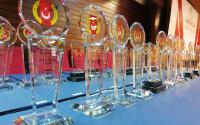Common Dreams / Published on Tuesday, December 5, 2006 by ReutersJim Wolf
The U.S. government is on its way to brokering about $20 billion in arms sales in the fiscal year that began October 1, steady with last year's near-record total, the Pentagon official responsible for such sales said on Monday.
"We're forecasting in the $20 billion range" for fiscal 2007, Air Force Lt. Gen. Jeffrey Kohler, director of the Defense Security Cooperation Agency, told the Reuters Aerospace and Defense Summit in Washington.
 |
In fiscal 2006, which ended on September 30, foreign military sales notified to Congress reached $20.9 billion, nearly double the $10.6 billion the previous year.
Last year's total was second only to 1993, which topped $30 billion, swollen by sales to the Middle East after the first Gulf War.
Regional security concerns tied to Iran and North Korea were helping drive current sales, Kohler said.
He said Saudi Arabia, for instance, was talking to the United States about shore-hugging littoral combat ships that could cost billions of dollars in coming years.
The ships were of particular interest to the Saudi Navy's Eastern Fleet "that would first confront Iranian aggression if there is any." The Eastern Fleet also was largely responsible for protecting Saudi oil infrastructure in the Gulf, Kohler said.
Such ships, costing some $220 million apiece, are designed to counter submarines, small surface attack craft and mines in heavily contested areas near shore. Different versions are being built for the U.S. Navy by teams led by Lockheed Martin Corp. and General Dynamics Corp..
The United Arab Emirates also was considering purchases designed to boost its naval capabilities, missile defense and command and control, Kohler said.
Sales to Iraq, including armored personnel carriers, plus equipment for Afghan government forces would total about $3 billion in fiscal 2007, about the same as last year, he said.
North Korea, which defied global pressure this year to test-fire missiles and carry out a nuclear test blast, is also spurring arms purchases, Kohler said.
Japan had been seeking to buy Patriot Advanced Capability-3 missiles faster than its original plan, and the United States expects South Korea to follow suit, he said.
"We're hoping that will be in their next budget," Kohler said. South Korea needs extra Patriot missiles, which could cost $50 million to $300 million, to deal with "the threat from North Korea."
India, for its part, may be moving closer to becoming a U.S. arms client, Kohler said, citing among other things relationships he had built in as many as 11 meetings over time held with some of his Indian counterparts.
Last month, he wound up "probably the best visit I've had out there," thanks to those relationships, he said.
Kohler made clear the United States was balking at Taiwan's interest in buying up to 66 advanced Lockheed Martin Corp. F-16 fighter aircraft until it follows through on a package of weapons it requested more than five years ago.
At issue is refusal by the Taiwan legislature, controlled by the political opposition, to purchase up to eight diesel-electric submarines, 12 P-3C Orion anti-submarine aircraft and Patriot anti-missile systems offered by President Bush in 2001.
"Until we see some movement on that, the U.S. government is reluctant to endorse an F-16 sale," Kohler said.
Taiwan has sought the F-16C/D fighter jets over a five-to-10-year period, in a deal that could be worth as much as $5.5 billion.






